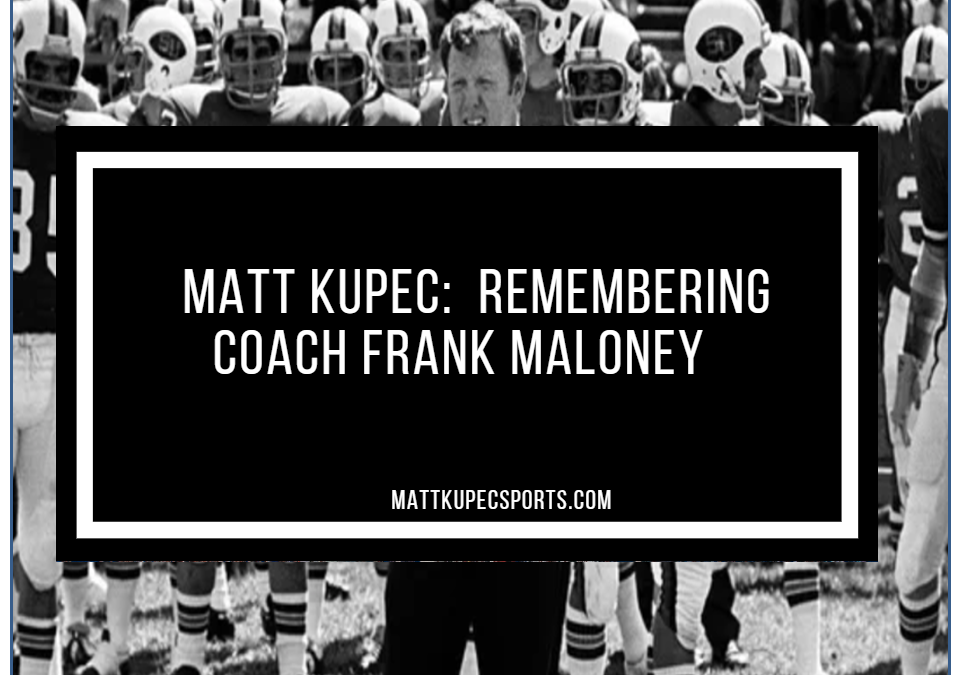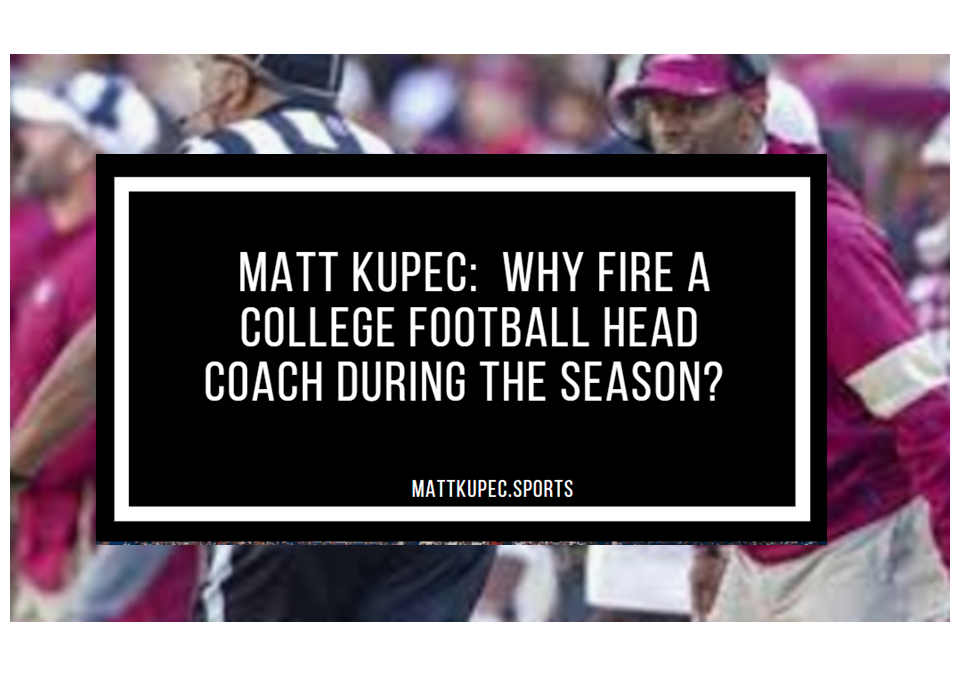
Matt Kupec: Remembering Coach Frank Maloney
by Matt Kupec
April 11, 2020
The college football world recently lost one of its former head football coaches with the news that Frank Maloney – a former Syracuse coach and Michigan lineman -— died at his home in Chicago, Illinois. Coach Maloney was 79 years old.
I hardly knew Coach Maloney but he is somebody I will never forget. I met him at a critical time in my life when I was a senior in high school in the middle of an intense recruiting battle for my services as a student-athlete as New York’s Football Player of the Year.
About Coach Maloney:
- He played center and guard at Michigan from 1959-61.
- He was an assistant football coach at Michigan from 1968-73, mostly under Bo Schemblecher.
- At age 32 he was hired by Syracuse to be head coach. The Orangemen went 32-46 in his six seasons
- In 1979, Syracuse went 7-5 played all of its games on the road because of construction of the Carrier Dome.
- Coach Maloney mentored 19 future NFL draft picks including Joe Morris and Art Monk.
Meeting Coach Maloney as a College Football Head Coach
Coach Maloney had just finished his first season as the Syracuse Head Football Coaching job going 2-9 in his inaugural season. I was the New York State Play of the Year as a quarterback after leading my Syosset High School team to an undefeated season and #1 ranking in the state .
One of Coach Maloney’s primary tasks was to focus on scouring the state of New York to keep the top New York high school football players in state. I was a prime recruiting target by Syracuse and Coach Maloney.
At the time Syracuse was really the only major college football option in New York. But the program was struggling and it had been a long time since the Orangeman had enjoyed any success. Syracuse was playing its home games in Archbold Stadium, a deteriorating facility that would be replaced by an new indoor stadium, the Carrier Dome, some five years later.
Despite being heavily recruited by Coach Maloney, I turned Syracuse down early and did not have them in my final five choices. I tried to be nice but Syracuse just wasn’t a good option for school for me at that time.
But Coach Maloney was relentless. Even after telling him no, he kept coming back to my high school week after week. It even got so bad that I remember hiding under a bench near the athletic office to avoid Coach Maloney on one his last trips to my high school.
I really admired Coach Maloney for his tenacity and relentless pursuit of me on the recruiting trail even after I had said no. It was a lesson of keep pushing that has helped shaped me in the business world.
Change of Careers
The other thing that impressed me about Coach Maloney – and I hadn’t realized this until his passing – was that he left the college coaching scene immediately after being fired by Syracuse to pursue a career in another field. That was an eye-opening revelation.
At the tender age of thirty-nine, Coach Maloney could have easily been hired by a number of schools as a coordinator or position coach. But he chose to leave college football altogether and make a change in his life. Maybe the hassles of recruiting, the demands on his time or he was fed up coaching led him to make the career change. Maybe he simply wanted a change of pace.
Coach Maloney moved back to Chicago and was hired by the Chicago Cubs where he became the director of ticketing for twenty-seven years before retiring from the Cubs organization.
In one article, former great QB Bill Hurley who played for Coach Maloney for four years was quoted as saying he talked to Coach Maloney regularly after he left coaching. Good for Coach to keep those relationships with his players well beyond his coaching years.
Rest in peace Coach Maloney. You made an impact on so many other student-athletes over the years. I am sure you had the same impact on the people you worked with in the Cubs organization. You made a difference in this world and you will forever be remembered. I will always remember you.
About the Author
Matt Kupec is a fundraising professional with 32 years of significant higher education development experience. He has directed four major university fundraising campaigns and nearly $5 billion has been raised under his leadership. He has led the fundraising programs at the University of North Carolina at Chapel Hill, Hofstra University, Moffitt Cancer Center & Research Institute and HelpMeSee, a New York City based non-profit. He is currently serving as Senior In-House Fundraising Counsel for Southern Illinois University-Carbondale, leading SIU’s recently extended campaign with an increased goal from $75 million to $200 million.
Matt is a former record-breaking four year starting quarterback for the UNC Tar Heels. During his career he set 19 season and career passing records. Two of which still stand — most consecutive games with a TD pass and most wins as a starting QB. Matt also set the ACC record for TD passes his senior year at UNC. Matt was named MVP of the 1977 Liberty Bowl and the 1979 Gator Bowl becoming the 1st player in Atlantic Coast Conference history to be named MVP of two bowl games.

Matt Kupec: Why Fire a College Football Coach During the Season?
by Matt Kupec
November 4, 2019
Florida State University made big news yesterday when they announced the firing of Head Football Coach Willie Taggert even though there still remain three games left to play in the season. Coming of a terribly disappointing performance in a loss to Miami, and standing at a record of 4-5, the Seminoles administration made the decision to fire Taggert because as FSU President John Thrasher said, “we had no choice but to make a change.”
So, Coach Taggart gets fired just 21 games into the tenure of his six-year contract at Florida State. He didn’t even get to finish his second season as the coach.
Why fire the head coach when the season isn’t done yet?
Don’t we preach to our student-athletes that we should never give up, never stop working and fighting to get better? The game isn’t over until the final whistle we have heard countless times? Don’t we believe in comebacks?
What is the purpose of a six-year contract when the Coach gets only 1 ¾ years to right the ship??
These are very important questions we must ask the leaders of higher education. Below you will find some of the reasons why in-season coaching changes are made in football. At the end of the day, it all comes down to money! Big money at the Football Bowl Subdivision level!
Don’t cry for Coach Taggert. His six-year contract was for $30 million, yes, $5 million per year. In addition to the two years worth of compensation he has already received, Coach Tagger is due approximately $20 million for the remainder of his contract. Oh, by the way, Florida State had to pay the University of Oregon $3M to buyout Coach Taggert’s contract from Oregon. And, FSU was also responsible for an additional $1.3M to the University of South Florida left on a buyout when he jumped ship early to take the Oregon job.
That’s over $34M that Florida State paid to secure the coaching talents of Willie Taggert. He gets to pocket the $30M for himself and avoids having to pay for the $4.5M in broken contract deals. Life could be worse!
By the way, Coach Taggert only stayed at the University of Oregon for one year.
Did anybody scream foul when he skipped out of Eugene early to take his “dream job” at Florida State. Probably the Oregon fans and supporters weren’t happy at the time. And what about the players Coach Taggert recruited to Oregon telling them that he was committed to them for their entire athletic careers at Oregon?
Get An Early Start on the Head Coach Recruiting Process. By firing Coach Taggert now, FSU gets to get its act together – if that is possible for FSU – and begin to prepare a recruitment package that will attract the next great head coach to Tallahassee.
I credit Jeromy Foley, the former great Director of Athletics at Florida for really starting this trend when he fired Ron Zook in 2004 during the season after an embarrassing loss to Mississippi State. Foley allowed Zook to complete the season but was able to start his recruiting process a good month before the other coaching jobs became available.
Florida had its sights on Urban Meyer who was tearing it up at the University of Utah. Meyer had in his contract a buyout waiver that would allow him to leave for Notre Dame, Ohio State and Michigan, his three dream jobs. Otherwise, Meyer was forced to pay a buyout penalty.
But Foley was able to get everything in order, start the process early, heavily recruit Meyer and was able to land Meyer even though Notre Dame fired Head Coach Tyrone Willingham at the end of 2004. Clearly, Florida’s head start allowed them to pull of this huge hire of Meyer to Gainesville instead of South Bend.
I saw first hand the University of North Carolina at Chapel Hill do the same exact thing in 2006 when it fired Head Football Coach John Bunting in mid-season. Following a bad 23-0 loss to Virginia on a Thursday night game, the decision to make a coaching change was made but not announced until November 12, 2006. Coach Bunting was allowed to coach the two remaining games against NC State and Duke. Ironically, UNC won both games.
During the short three week search, UNC had their sights on Butch Davis at the time who was working as a football television analyst after being fired from the Cleveland Browns. Rumors were swirling at the time that the University of Alabama was getting ready to fire their head and the Crimson Tide had interest in Coach Davis. It might have only been Coach Davis’ agent spreading that word, but UNC got nervous and announced the hiring of Coach Davis on November 12th with two weeks left in the football season. UNC held off having a press conference until the end of the season on November 27, 2006. Wasn’t that considerate?
By the way, Alabama wound up hiring Coach Nick Saban to Tuscaloosa on January 3, 2007, just five weeks after firing Head Coach Mike Shula at the end of the Alabama season. The hiring of Coach Saban has worked out pretty well for the Crimson Tide!
One’s Coaching Status Has Often Turned Into a Game to Game Referendum. With so much media attention and so many media options available, there is an enormous need for content to fill the 24 hours of non-stop sports reporting and analysis. As a result, we find stations 24/7 with “pundits” and “experts” espousing an opinion, often looking to spark controversy.
Coaches today have to deal with the constant chatter about the status of their programs and their jobs. We have become quick to jump to conclusions and look for a immediate pivot. Yesterday’s scapegoat can become tomorrow’s overnight hero and a fixture on ESPN’s “top ten” highlights.
Can you believe that Head Coach Mack Brown was able to endure consecutive 1-10 seasons to start his initial UNC tenure in 1989 without the fear of being terminated. Mack was greeted with standing ovations and encouragement as he entered his third year in Chapel Hill. Can you believe that?
Clay Helton at USC can have a big win and follow the next week with a loss and every article is predicting his demise as USC’s head football coach. Can you image coaching through that noise every day? Can you imagine the heat Coach Helton is feeling today following the blowout loss to Oregon on Saturday?
I remember Mack Brown’s last year at Texas. Mack was a Hall of Fame coach who brought Texas its first national championship in 35 years with the incredible win over USC. Mack won at least 10 games in a season for ten seasons. But yet, in his final season at Texas, coming off 8-5 and 9-4 seasons, each Texas game would bring an outcry of rumors regarding a possible and rumored change. It was awful!
My first true exposure to the concept of the “game to game” referendum that coaches face occurred in 1999 when Carl Torbush was in his first year as UNC’s head football coach following Mack Brown’s departure to Texas. Carolina had lost its opening two games – to Miami, Ohio (with Ben Roethlisberger at QB) and Stanford in Palo Alto.
In the third game, a home contest against a good Georgia Tech team, UNC fell behind early. In the Chancellor’s Box where guests are hosted by the UNC Chancellor, Michael Hooker the brilliant and inspiring Chancellor pulled me aside and said, “I am going to fire Coach Torbush at the end of the game.”
I remember, saying, “you can’t fire him, it’s only the third game of the season.” UNC lost the game and didn’t fire Torbush but that is exactly the moment I became aware of the “game to game” referendum pressure that is upon coaches today.
Make the Change When You Have Decided to Make the Change. Coaching changes are immediately made after a bad loss that has followed some underwhelming performances. You want to strike while the situation is bad. Almost sounds like rooting for a loss but that is the reality of a situation where the administration wants to make a change! Occasionally, a team – take LSU with Head Coach Les Miles a couple of years ago – rebounds with its coach under pressure, plays well and wins a number of games in a row. The coach job is saved. It worked for Coach Miles but only for four games into the next season when he was fired after a tough loss to Auburn.
Back to former UNC Head Coach Carl Torbush. He wound up getting through the rocky start I mentioned earlier but struggled throughout his tenure as UNC’s head coach. In his third year, the UNC administration made the decision to fire Coach Torbush after the Duke game, the last game of the year. Win or lose, he was gone.
The senior administrators were told of the plan at an early Friday morning meeting the day before the Duke. I spoke up and recommended that the announcement should be made that Friday because UNC would go out and blow out a very bad Duke team the following day and there would be a groundswell from players to get the Coach. Please know that I really liked Coach Torbush and respected him so much, but it just wasn’t working with him at the helm and the UNC football program was not in good shape.
Turns out, UNC blew out Duke 38-0 and there was, indeed, a huge groundswell after the game by the players to keep Coach Torbush. The administrators recanted their decision and kept Coach for the following season. Interestingly, a 6-5 season with three consecutive wins at the end of the season was not enough to save Coach Torbush’s job and he was terminated as head coach.
It’s All About the Money. Let’s be very clear that in season head coaching terminations are made to appease the fans, the alumni, the ticket holders, the general public. But most of all, the decision is made in reference to the major donors.
It is been reported that Florida State boosters contributed $20 million to a fund to buyout Coach Taggert’s contract! Donors anted up $20 million to allow the firing of a coach not even two years into his six-year contract.
The next head coach will probably be paid in the $5 million to $7 million range.
College athletics is a very, very big business and FSU did not flinch at having to find $20 million to payout its head coach. Football success is very important to a school like Florida State University. The sport brings so much attention and awareness that help drive the other parts of the University.
At FSU, when football – it’s main revenue and marketing machine – begins to decline, coaching changes will be made quickly despite the fact that a coach has 4 ½ years remaining on his contract. This will not change! The dollars are too huge and the impact on football is too great to ever seeing this trend reverse itself.
After all, this is big-time college sports!
Lifelong athlete
Athletics have always been an important part of Matt Kupec’s life. Born and raised in Syosset, NY on Long Island as the middle child of seven children of Bill and Helen Kupec, Matt enjoyed a prolific high school career as an outstanding student-athlete to become one of the most decorated high school athletes on Long Island.
About Matt
A three sport star – football, basketball and baseball – Matt Kupec earned many honors and awards including prep All-American in football where he led his Syosset HS football squad to an undefeated season and #1 ranking as the top High School team in New York. Matt was also awarded the highly coveted Thorp Award, given to the top player in Nassau County.
Matt Kupec was an all-county player in all three sports during his high school career. Please remember that Nassau County has over 80 public and private high schools. As a basketball player, Matt was a sharpshooting point guard in basketball with a career high game of 34 points at a time when the three-point shot was yet instituted. In baseball, he was a pitcher and shortstop. In Matt’s senior year in high baseball, he pitched three games during Syosset’s march to the Nassau County semi-finals – a one-hitter, a two-hitter, and a three-hitter. Matt struck out a combined 21 batters, gave us just 6 hits, and walked zero – yes zero – batters in those 21 innings.
With many full scholarship offers to choose from following his successful football career, Matt Kupec chose to accept a full scholarship to attend the University of North Carolina at Chapel Hill because of its high academic standing and strong football program.
At UNC, Matt was the starting quarterback for four years and led the Tar Heels to bowl games in three of the four seasons. He was named Most Valuable Player in the Liberty and Gator Bowls becoming the 1st player in Atlantic Coast Conference history to earn two bowl game MVP awards.
Matt Kupec set nineteen season and career passing records while a UNC quarterback. In fact, two of those records – most consecutive games throwing a touchdown pass and most wins as a starting quarterback – remain standing nearly forty years after his playing career. Matt led the ACC in five passing categories his senior year including setting an ACC record for most touchdown passes in one season.
After a brief stint with the Seattle Seahawks as a free-agent quarterback, Matt Kupec began a long career in higher education as a fundraising executive with stints at the University of Bridgeport, Hofstra University and twenty-one years at the University of North Carolina at Chapel Hill. In these roles, Matt played was actively involved with the athletic administration staffs and coaches in raising money to support the athletic teams at these institutions.
Of the philanthropic gifts that Matt helped to raise for athletics, the most significant gift was the lead gift form Charles “Charlie” Loudermilk to fund the building of the Loudermilk Center for Excellence within Kenan Stadium on the University of North Carolina campus, a 150,000 square-foot facility that serves all of UNC’s nearly 800 student-athletes across 28 sports.
All of these experiences as an athlete and as a higher administrator supporting a wide variety of men’s and women’s athletic programs, have given Matt Kupec an insight and perspective to the athletic world that few have experienced.

Latest Post from Matt:

Matt Kupec: Remembering Coach Frank Maloney
by Matt Kupec April 11, 2020 The college football world recently lost one of its former head football coaches with the news that Frank Maloney – a former Syracuse coach and Michigan lineman -— died at his home in Chicago, Illinois. Coach Maloney was 79 years old. I...
